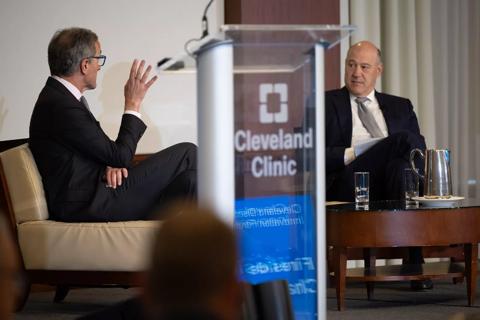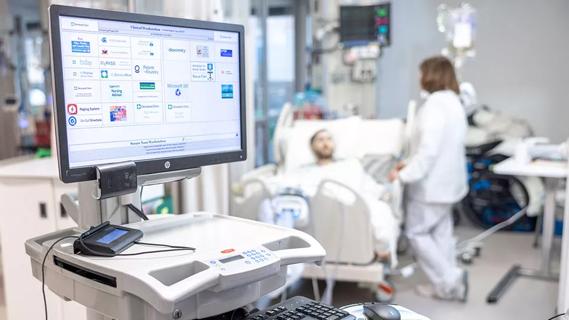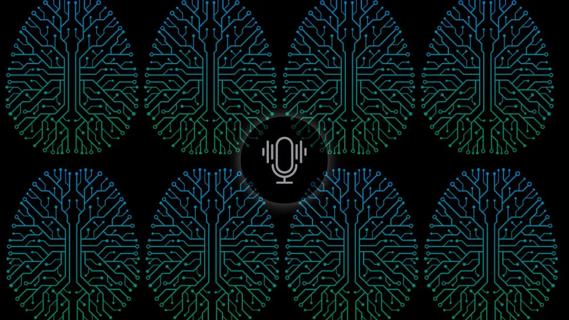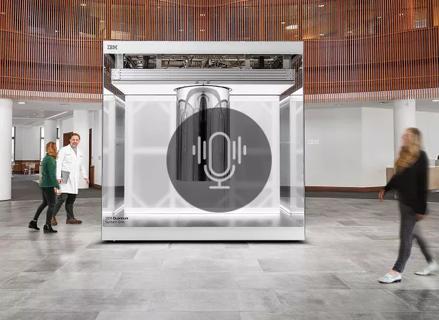Advanced software streamlines charting, supports deeper patient connections

Documenting a patient’s clinical visit for the medical record is essential, but it’s not any caregiver’s favorite activity.
Advertisement
Cleveland Clinic is a non-profit academic medical center. Advertising on our site helps support our mission. We do not endorse non-Cleveland Clinic products or services. Policy
It’s labor-intensive and time-consuming, often requiring after-hours work to complete. Note-taking and charting during an exam can also make patients feel they don’t have the provider’s full attention, hindering connection-making and trust.
Cleveland Clinic is implementing a solution. After an extensive testing period, more than 4,000 physicians and advanced practice providers have begun using artificial intelligence-powered ambient listening software that automates and streamlines clinical documentation.
AI Scribe, developed by the technology company Ambience Healthcare, records the conversation during a patient’s visit using a phone-based app — with the patient’s consent — and generates a comprehensive, medically structured report in Epic, the electronic health record, as well as an after-visit summary for the patient.
Early reviews have been positive, with caregivers thankful for the time the software has helped them save.
“We had quite a few skeptics who doubted the technology would work. And they’re like, wow, it actually does,” says Cleveland Clinic Associate Chief Medical Information Officer Eric Boose, MD, who was the physician lead on the year-long pilot project that evaluated various AI clinical documentation tools before selecting Ambience’s.
“The promise of AI in healthcare is that it will enable us to care for patients with a higher level of safety and quality, and a better patient and caregiver experience,” says Rohit Chandra, PhD, Cleveland Clinic’s Chief Digital Officer. “Our implementation of ambient AI technology delivers on that promise because it helps our providers fully engage with their patients, saves time and alleviates some of their administrative burden.”
Advertisement
Recording the details of a patient interaction has evolved from jotting on a piece of paper to typing at a computer keyboard, but notetaking methodology has remained inefficient and an impediment to communication.
Clinicians listen and ask questions while documenting the exam, but it's not the same engagement as in a direct conversation. “They're losing that face-to-face time,” Dr. Boose says.
Software capable of converting speech to digital text has been around for several decades. In fact, the first commercially available product able to recognize continuous speech — IBM’s MedSpeak, introduced in 1996 — was created specifically to help with physicians’ workflow. The tool enabled radiologists to dictate, edit and approve medical imaging reports using a personal computer rather than relying on a transcriptionist.
Speech-to-text utilities have since become more adept, with larger vocabularies and the ability to differentiate multiple speakers, increasing their usefulness in various settings, including healthcare. Cleveland Clinic has used speech-to-text for years to transcribe clinical encounters.
But clinicians still have to turn that transcription into a meaningful, contextual document for the electronic health record. “You're starting from scratch, really, except for reflecting on your notes from the visit,” Dr. Boose says.
AI’s emergence is changing things. Its application to speech-to-text is elevating formerly stenographic software to another level, adding analytic, interpretive and summarizing capabilities.
Advertisement
More than a dozen such ambient listening products, as the technology has become known in the healthcare field, already are on the market, developed by start-ups and established firms. “We wanted to make sure we chose the right one,” Dr. Boose says.

In 2024, Dr. Chandra and Cleveland Clinic’s Strategy Office selected five ambient listening products to be evaluated. Approximately 250 physicians representing more than 80 specialties and subspecialties were recruited for the pilot project. They were divided into groups of 50 and assigned to try out one or more of the tools.
“We chose people who liked using technology, but we also identified people who were struggling to get their charts closed, who took a long time to do their documentation,” Dr. Boose says. “We identified people in those pockets in certain specialties and asked them if they'd like to try a tool that may be able to help them. Most of them said, ‘I'll try whatever I can to help get my work done.’ ”
To evaluate the five ambient listening software products, the pilot project team used both objective and subjective data. They assessed the tools’ accuracy in characterizing physician-patient interactions and generating medical chart entries. They tracked whether physicians’ time spent closing charts in the electronic health record was reduced when using ambient listening software. Pre- and post-use surveys gauged physicians’ attitudes about the tools’ ease of use and whether they eased worry, cognitive burden and feelings of burnout.
Advertisement
At the end of the pilot phase, Ambience was chosen based on its software’s performance and the potential to refine the product and collaborate on additional applications, such as generating clinical orders and recommending billing codes.
With AI Scribe selected, Cleveland Clinic began disseminating the software to its U.S. clinicians in ambulatory settings and conducting training sessions for users in spring 2025. Providers were not required to use the tool.
The rollout occurred in three phrases. Live virtual training sessions for groups of 50 were held three times per day. Out of 6,000 eligible physicians and advanced practice providers, more than 4,000 were actively using the software within 15 weeks.
In addition to Cleveland Clinic’s requirement that physicians review and approve AI-generated content before it’s entered into the electronic health record, patients must give verbal consent for the software to be used. Although there are no formal government regulations regarding patient sign-off, “we felt like our patients should be a partner in this project,” Dr. Boose says. A flyer helps explain the concept and details.
Preliminary results show high adoption and retention rates and quicker chart closures with AI Scribe. Cleveland Clinic providers already have used the software to document and summarize 1 million patient encounters. Active users are relying on it for 76% of their scheduled office visits. AI Scribe has reduced the average time clinicians spend writing and reviewing notes in the electronic health record by two minutes per appointment and 14 minutes per day.
Advertisement
“People are getting their documentation done faster and are spending less time after hours,” Dr. Boose says. “And patients love the detailed notes and instructions. We’re definitely moving the needle in the right direction.”
Quantifying return on investment will require more time and deeper analysis. Potential impacts, Dr. Boose says, are in billing and reimbursement, patient access, and caregiver retention and recruiting.
“One thing we’re watching is what the software recommends for coding the visit,” he says. AI Scribe’s record of the amount of time spent with a patient, the degree of complexity of the session and the number and kinds of medical tests ordered could help ensure reimbursement is commensurate with the level of care provided.
Additionally, less time required for clinical documentation could free up time to see patients. And decreasing administrative workload and stress should ease job burnout and perhaps convince physicians who are mulling retirement, reduced hours or quitting to reconsider. Retaining those physicians and attracting others would improve patient access.
“There’s some anecdotal evidence from the pilot project of people saying, ‘I was thinking about retiring or cutting back to part-time, but with this tool I could continue to work,” Dr. Boose says. Also, ambient listening software “actually could be a recruiting tool for physicians who may be looking for this kind of help with their practice.”
Cleveland Clinic’s early experience with ambient listening software already has produced some takeaways:
Advertisement

Cleveland Clinic uses data to drive its AI implementation strategy

Cleveland Clinic and IBM leaders share insights, concerns, optimism about impacts

Customized bots improve speed, efficiency by streamlining daily clinical, clerical tasks

Cleveland Clinic neuromuscular specialist shares insights on AI in his field and beyond

Neurology is especially well positioned for opportunities to enhance clinical care and medical training

How technology is changing how and whom we hire

How a Cleveland Clinic/IBM quantum computer partnership aims to hasten discoveries

Discovery Accelerator Partnership with IBM Deploys Advanced Computing Technologies to Supercharge Healthcare Research